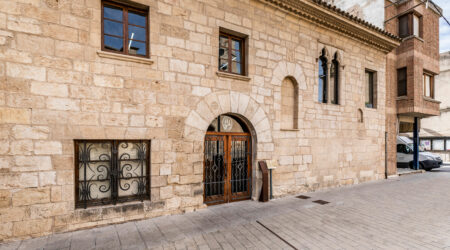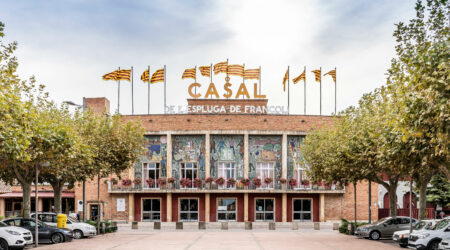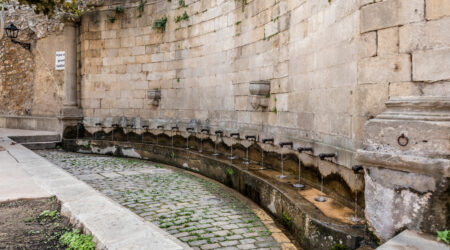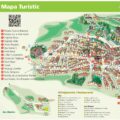A walk through l’Espluga de Francolí

Old Church

New Church
(1860-1888) Neoclassical in style, it was built with stones from the old castle that was the manor of the town during the Middle Ages. Although the project provided for the construction of two bell towers, the agrarian crisis meant that only one could be built. Not visitable.

Old Hospital
The Old Hospital is a Catalan Gothic building that was built between the 15th and 16th centuries that welcomed the sick, poor and orphans. Its activity will continue until the end of the 19th century. The ground floor has an interior patio, which connects with the convalescence room, the chapel and the mortuary deposit, while on the first floor, which is accessed through the stone staircase, there were two large rooms. On the façade you can see the shield of the town dated 1528. Visitable with the Templaria y Hospitalaria Route.

City hall
Since the end of the Middle Ages, this building has housed the City Hall offices. On the main façade you can see the town’s coat of arms from 1563, formed by three towers, which represent the medieval castle that dominated the town, crowned by three crosses, which refer to the domain of the order of the Hospital of Saint John of Jerusalem. , by the river and by the cave, birthplace of the Francolí River and origin of the name of l’Espluga.

Paseo Cañellas
On October 19, 1900, this walk took the name of Joan Cañellas y Tomàs, a liberal deputy and lawyer who defended 22 espluguins prosecuted for sedition, arson and murder of the executive collector Josep Espina, crimes of which they were acquitted. In May 2010, the current remodeling was inaugurated. The wrought iron railing is the work of the master forgers of Biel lime. It evokes some of the ancient trades established on this walk (blacksmith, innkeeper, farmer, carter, animal shearer, carpenter, apothecary…)

Casal de l'Espluga
The Casal de l’Espluga was founded in 1963 under the impulse of the patron of Catalan culture and espluguín patrician Lluís Carulla i Canals.
It was built according to the plans of the architect Lluís Bonet y Garí. The main façade was decorated by Luciano Navarro. The Casal has become a promoter of the socio-cultural and sporting life of l’Espluga.

Birth of the Francolí River and Font Major
La Font Major is considered the birthplace of the Francolí River. You can see the old laundry room (1904), the fountain (1864), the stairs, the Virgin Mary of the Font Major and a plaque that remembers the level where the water reached during the Santa Tecla flood of 1874.

Font Baixa
The Font Baixa, built in its current form in 1852, is made up of 17 cinnamon sticks that correspond to each of the letters of the town’s name, Espluga de Francolí.
The wrought iron railing that borders the fountain is the work of the master craftsmen of Cal Biel de l’Espluga.

Ermita de la Santísima Trinidad
Hermitage located at the foot of the forest, surrounded by riverside forests and fountains. passes the GR-175 that connects the Monastery of Poblet with Montblanc. The current building, cataloged in the inventory of the Architectural Heritage of Catalonia, is a work from the 18th century. The new image of the Holy Trinity (1938) is venerated, a replica – made of marble by Frederic Marés – of the original 15th century image destroyed by the Civil War, according to tradition, discovered inside an old oak tree next to the sanctuary. Recreation area and to make meals.

Aerial photo of the L’Espluga Hostel by Francolí Xanascat.
Source: l’Espluga de Francolí City Council
Les Masies and the International Brigades. Memory space.
“You have come to Spain, spontaneously, to defend our country (…) out of your own will to sacrifice what is most difficult for anyone to do: to sacrifice life. You came to defend justice, the mocked right, because you also knew that here, in Spain, the freedom of the entire world was at stake.”
Fragment of the speech by Juan Negrín, president of the Council of Ministers, delivered in the Masías.

Albert Einstein on Font de l’Espluga street in Francolí on Sunday, February 25, 1923.
Source: Casimiro Lana Sarrate / General Administration Archive [IDD (03)88, F/03198, S10, F15]
Visit of Albert Einstein in l'Espluga de Francolí
Josep Puig i Cadafalch, then president of the Commonwealth, wanted to show Albert Einstein the medieval past of Catalonia, with a visit to the Monastery of Santa Maria de Poblet.
Before the visit, Einstein made a stop in l’Espluga de Francolí, to eat at the Fonda Ibérica.
After the meal, the photographer immortalized one of the unique photographs of the visit.


